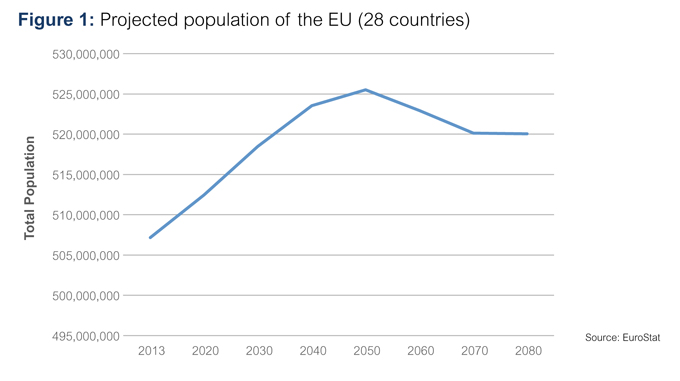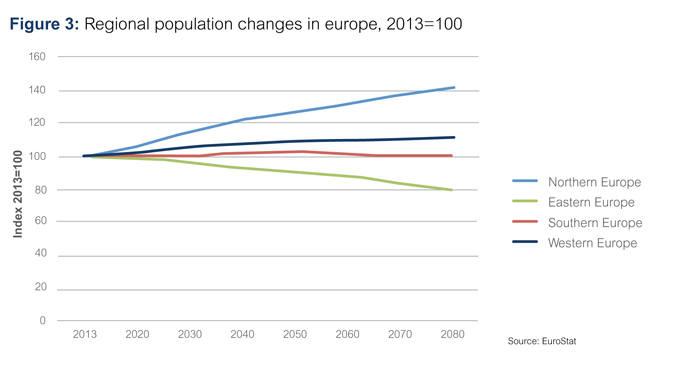With the growth in population whether young or old comes the necessity for economic growth. The complexities of globalization pose various challenges. One of these being the necessity to welcome contributing migrants. Are these migrants, the developed world’s gain and the developing world’s loss? Both statements are justified.
The most important factor, the fertility and the birth rates in the developed world have been on the decline while the population of the retirees is on the up and up. Sum that up with the shrinking and projected downturn in the young population in many parts of Europe, including Germany and you have a perfect formula for recession and in the worst case a deep depression.
The social structure, will in all probability, remain what it is in different parts of the world in the foreseeable future. The safety net in most parts of the developing world is the family. It’s usually a given, that parents in the developing world try to go beyond their means to send their children through school and university and the offspring look after their parents once they are retired. In most cases if a family member loses her or his job the rest of the family looks after her or him until they find gainful employment again. This system along with economic growth, it would appear, works well enough since a fair percentage break the barrier to jump upwards to what we know as the middle class, each month. The developed world, on the other hand, has a sophisticated social security system which includes medical benefits, unemployment benefits, government funded schools and pensions to name a few. The question is, with the aging population growing and the young population on the slide, is this sustainable?
Let’s first look at sheer numbers, mind boggling as they are. The population of those over 65 in the U.S. is on the upsurge and is expected to reach 88 million by 2050 from the present 48 million. That’s a whopping 83 percent increase. The percentages for Europe are equally alarming and point to 33 percent of the population being over 65 by 2050.
Now let’s have a quick look at more figures. The population in Sweden and most of North Europe will likely remain constant or rise at the same time the projections show that the population of Germany, Hungary, Slovakia and the Czech Republic will fall by approximately 20 percent, assuming no immigrants are allowed into these countries. France is an exceptional case which shows a good birth rate and an increase in the number of inhabitants to 70 million by 2050 from the present 64 million. A fair portion of this is attributed to the fertility rate being better than the rest of Europe and the 35 hour work week. Hungary, Slovakia and the Czech Republic have the combined issue of low fertility rates and emigration by the young. More of the females than males appear to be leaving these countries.
The median age in most parts of the developed world has risen by 8.3 years in the last half a century and is expected to rise another 7 years by 2050. Thanks of course to the convenience of living, a much better diet and advances in medical care.
Such being the case of mostly a constant or a declining population, an appreciable increase in life expectancy, the phenomenal increase in the numbers of those of age 65 and above, the vast increase the numbers of those who will need supplemental or even extraordinary care, times are going to be challenging.
Ultimately this is going to put an immense pressure on the young. Other consequences, risk of poverty in population over 65 and many having to work right into their old age if there’s a breakdown in the system.
Ageing does have a cost.
According to studies conducted by reputable universities and international organizations, migrant labour is not just appropriate but necessary, given the times we live in, of globalization and interdependence among countries. It is the migrants that fill the gap for economic growth with the transfer of human power to provide for the paucity not just for the basic skilled labour but also the needed knowledge and innovation.
Now let’s have a careful look if the migrants are a drain on the society or if they are important contributors.
On a net net basis the theories and opinions that ‘migrants steal our jobs’, ‘migrants are a burden’, ‘crime rates are higher among immigrants’, have all been debunked time and again, using solid statistics.
The World Bank and the UN’s International Labour Organization and the OECD have clearly established and issued reports that in most countries migrants pay more in taxes and social contributions than they receive.
Here we take some specific examples. Since the U.S. department of statistics publishes such data, let’s have a look at real numbers based on ethnicity. The average income of an American household according to the latest numbers is $55,775. When we cut it, slice it and dice it, viola, the average household income by ethnicity is, Indian $ 101,591, Taiwanese $85,566, Fillipino $82,389, European $77,440 and Russian $77,349. This would clearly go on to show these income groups pay more taxes.

Illustrative Photo
Question is why do these groups pay more taxes? Research has shown that the highly educated are the ones from the developing countries who are the most predisposed to migrate. The second group is made up of the young. These are the ones between 20 and 40 years of age. Many of these are employed in highly manual occupations such as road and rail building working in mines and foundries etc.. Those above 45 usually have no desire to migrate to another country unless they are loaded with money and migrate to comfortable countries to live in retirement and spend.
Carlos Vargas-Silva of the Oxford university was clear in his report and substantiated it with numbers that in the UK alone if 260,000 migrants are to be admitted each year, their contribution would be such that the public debt of the country would be cut down to half 50 years from now. Which would show that migrants would contribute heavily towards the comfort of the future generations. Germany, Hungary, Slovakia and the Czech Republic need much higher numbers of migrants on a percentage basis.
Another study shows that non Europeans living in the UK since the last 22 years have brought in 35 billion Pounds worth of education with them
Again, entirely based on published data, the immigrant population, almost in all countries, commits far lesser crime when compared with the average individuals.
Whether we like it or not, our individual and collective lives are intertwined across boundaries than ever before. The largest infrastructure project is the world itself. The migrants usually look for a better life when they move countries and the developed world is going to need the migrants for some decades to come.
Photos: Shutterstock
Support us!
All your donations will be used to pay the magazine’s journalists and to support the ongoing costs of maintaining the site.
Share this post
Interested in co-operating with us?
We are open to co-operation from writers and businesses alike. You can reach us on our email at [email protected]/[email protected] and we will get back to you as quick as we can.











